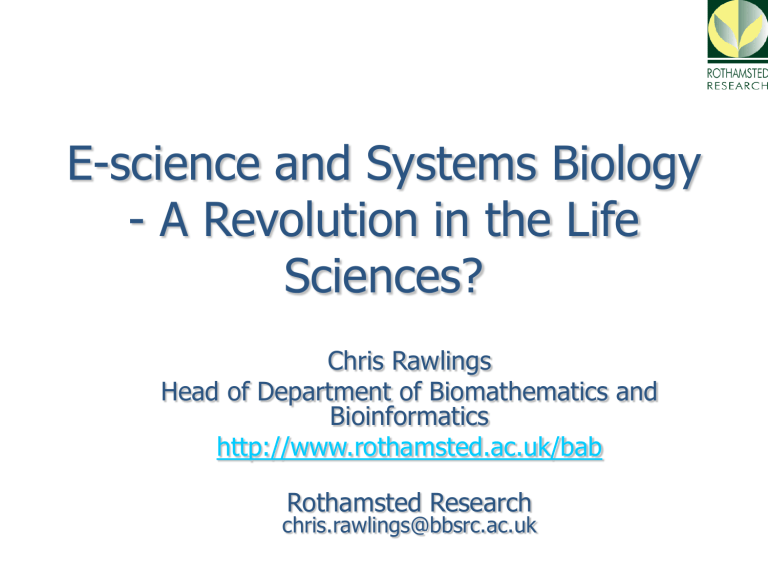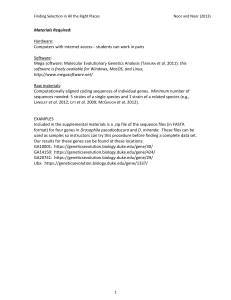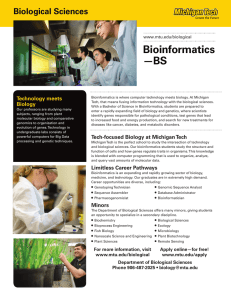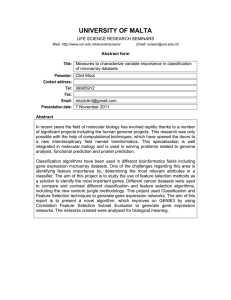E-science and Systems Biology - A Revolution in the Life Sciences? Chris Rawlings

E-science and Systems Biology
- A Revolution in the Life
Sciences?
Chris Rawlings
Head of Department of Biomathematics and
Bioinformatics http://www.rothamsted.ac.uk/bab
Rothamsted Research chris.rawlings@bbsrc.ac.uk
Outline
Rothamsted Research
Systems Biology, Bioinformatics
Integrating Data
Text Mining to Support Database Curation
Systems Modelling
What are the issues?
Rothamsted Origins
Rothamsted Research
• Largest agricultural and crop science research institute in UK
• Research started in 1853
• 400 Staff
• Funding BBSRC (55%)
• Others Defra, EU, Industry
Sir Henry Gilbert Sir John Bennet Lawes
The classical experiments
Rothamsted Soil Archive
Dioxins & fura ns, mg/ kg
100
80
60
40
20
1840 1 860 1880 1 900 1920 19 40 1960 19 80
Yea r
5
3
7
Lea d mg/ kg
1
1955 1965 1975 1985 1990
Yea r
New Approaches – High throughput science in agriculture research
Rothamsted’s Five Research Centres
The impacts of climate change on agriculture and approaches to its mitigation
Development of arable crops with improved resource use, performance, yield and end-use quality
The vital functions performed by soils and agricultural ecosystems
Effective and lasting approaches to reducing the impacts of pest and disease
Use of informatics, mathematics and statistics to derive added value from large volumes of complex noisy data. (E-science)
Research style
Mixture of basic and applied research
Translational research important
BBSRC->Defra->farmers->processors
Strongly interdisciplinary
plant, insect and microbial molecular and cell biology, plant and insect ecology, soil science, chemistry, physics, mathematics, statistics, bioinformatics
Increasing use of molecular biological approaches to understanding:
Interactions between plants and their pests and pathogens including disease resistance
Biological diversity in above and below ground ecosystems
The mechanisms controlling the productivity of crop plants and their responses to biotic and abiotic stress
Example Systems
Plant-pathogen interactions
Managing disease resistance in crops
Understanding how pathogens evolve to overcome host defence
Interactions between plant, pest and biological control mechanisms (or agricultural practices)
Signalling between plant, pests and beneficial insects or plants
Chemical ecology – natural methods of pest control
Interplay between crop plant, nutritional or disease status and weather
Impact of climate change
Role of soil microbes interacting with plant roots and soil chemistry
Production/sequestering of greenhouse gasses
Systems at a range of scales
Scale
Modelling approaches
Landscape Geostatistical methods and wavelets
Deterministic and stochastic models
Systems models (Petri Nets)
Ecosystem
Field
Plant
Cell
Pathway
Signalling and
Metabolic Pathways
Systems Biology
Systems Biology - Two Definitions
Systems
Biology
Emphasizes Systems
Approaches
Predictive modelling
Multi-scale
Up-scaling, down-scaling
From genes and biochemical pathways to whole organism behaviour
Collaborations between biologists, mathematicians, engineers and physicists
Emphasizes
Integration
Holistic approach
anti-reductionism
Whole genomes
Comparative analysis
High throughput technologies
‘omics
Data integration
Ideal Situation
Modelling/simulation
Clear goals
Study has a design
Expressive models
Computing power
Experimentalists
Simulation
Validation
Prediction
Revision
Reliable technology
Reproducible biology
Adequate resources
Quality data
Adequate resolution
High throughput
Experimental platforms
Common Requirements
Modelling/simulation
Clear goals
Study has a design
Expressive models
Simulation
Validation
Prediction
Revision expertise throughout project to define and structure development
Experimentalists
Reliable technology
Reproducible biology
Adequate resources
Quality data
Adequate resolution
High throughput
Experimental platforms
Additional
Data for model validation
Bioinformatics and E-science
Bioinformatics and Escience
The use and development of computer systems for the analysis and management of biological data
Underpins genomics and the use of high throughput molecular biology
Key component in systems biology
G E N O M I C S
B I O I N F O R M A T I C S
Data volume is not the only important factor
By comparison with other domains, the volume of data is not that great
The real challenges are:
The interrelatedness of all these data
The complexity of the dependencies
The incompleteness of the data
Interrelatedness of databases indexed by SRS in ‘96
Complexity of interactions
Biomathematics and Bioinformatics at Rothamsted
Integrate data from multiple biological sources and develop tools to analyse and interpret results
Exploit mathematics and computational sciences to develop methods for detection of subtle signals in complex and noisy datasets
Develop predictive systems models of plants and their interactions with pathogens and the environment at a variety of scales
Validate and apply the models to support the development of sustainable agricultural practises
Access to Data is Key Requirement for Integrative Systems Biology
Data integration platform - ONDEX
Semantic integration
Visualisation
Text mining
Data Integration
Data Integration
ONDEX system
http://ondex.sourceforge.net
Key features:
Treats all data as components in a graph of concepts linked by edges with defined semantics
All information is a network
Ontologies provide key to linking across information types
Specialist treatment of text and sequence information
Client server architecture
Recent version exploits emerging GRID technologies to enable open access to ONDEX-integrated data resources
ONDEX principles
everything is a network… protein interactions metabolic pathways
… in which the nodes and edges have different properties ontologies
Main idea
Simple graphs
Protein binds
Cofactor
Protein binds
Protein
Relations
Edges
Concepts/Entities
Nodes binds
Substrate binds
Enzyme catalyses
Product
Best analogy is a map
Think of it as layers which can be combined in different ways to answer particular questions
Integrated Analysis of ‘Omics Data
ONDEX for Gene
Expression
Use integrated information to help provide biological context/explanation for the pattern of up/down regulated genes
Sequence
Transcription
Factors
(TRANSFAC)
Gene
Ontologies
(GO)
ONDEX
Data Integration
Biochemical
Pathways
(Kegg, AraCyc)
Enzyme
Reactions
(BRENDA)
Gene
Expression
Data
Could be other ‘omic data
Parsers available for 14 data formats:
Kegg, AraCyc, MetaCyc,
BRENDA, Cell Ontology, OBO
Ontologies, Drastic, Enzyme
Commission, Mesh, Transfac,
Transpath, Human disease ontology, mouse pathology
Pilot Study
Gene Expression Analysis
-
-
-
Parani, M., et al. (2004) Microarray analysis of nitric oxide responsive transcripts in Arabidopsis. Plant Biotechnology
Journal , 2, 359-366 .
Published study of NO signalling (stress)
List of statistically significant differentially regulated genes
Re-interpret in context of integrated data relating to plant signalling mechanisms
Graph Visualisation & Analysis
Pilot Study
Arabidopsis data with 120 “novel” genes
New observations not in original paper made because of access to integrated data:
provided annotation to 50 “novels”
an important “unspotted” gene (a TF)
drought stress
jasmonic acid biosynthesis
Köhler, J., Baumbach, J., Taubert, J., Specht, M., Skusa, A., Rueegg, A.,
Rawlings, C., Verrier, P. and Philippi, S. (2006)
Graph-based analysis and visualization of experimental results with
ONDEX. Bioinformatics 22(11):1383-90.
Text Mining for Database Curation
Database of genes from plant fungal pathogens
Validated by gene disruption experiments
Extended to other pathogens
Research question - use of text mining to improve search for additional genes
Supplement manual methods
Pathogen Host Interactions Database
To fight pathogens one can a) reduce pathogenicity b) increase resistance in hosts
First version of PHI-base
Curated experimentally validated genes that result in loss of infection function
Generic for any pathogens and hosts (not only fungi and plants)
Why have a database
support analysis of experimental results identify key pathogen genes and families across species how are the genes related?
pathway analysis starting point for fungicide/drug target identification
Original Curation Process
Papers
Curator
Original situation
Post-doc and PhD Student curators
Simple literature search terms
Read abstracts to select relevant articles
Read paper to abstract detailed information
Time consuming
Potential for missing genes
Free text, no controlled vocab
No links to other database
Not scalable
Capture in spreadsheet not suitable for DB
Text Mining to Support Curation
Papers
Text mining
Curator(s)
Web Frontend
Relational
Database
(PostgreSQL)
PHI-base Database
Principles
Interoperability with external data sources
use controlled vocabularies, ontologies, taxonomies linkout to external data sources use stable accession numbers so other data sources can link to PHI-base
Text Mining Results
Compared with manual curators – trying to recreate same content
3 Concept groups: gene symbols, pathogens and hosts
Precision 41% (41 / 100 extracted abstracts)
(60 different genes, 7 new genes)
Recall 70% (104 / 150 extracted abstracts)
Mixed results:
Reduced recall and precision – but not that bad for first attempts with simple term co-occurrence
Found new genes
Combined manual and text mining
Current status
Collaboration with National Centre for Text mining
More advanced text mining methods
Improve precision and recall
Data extraction
Extend Web front end to support curation
Grow curator community
Improve content (further funding)
Modelling Plant Biochemical
Systems
Many groups in RRes study complex signalling and metabolic pathways
Create mutant plants
Single targetted gene knocked-out
Phenotype not always easy to predict
Develop predictive biochemical systems models
Formalise pathways and biological hypothesis
Use to predict phenotype from model
Biological pathways represented as Petri nets
Gibberellin biosynthesis
Gibberellin biosynthesis
Gibberellin biosynthesis
Experiment
Petri Net
ODE
Control
GA 2-ox
Control
GA 2-ox
Control
GA 2-ox
GA
4
99
16
205
9
GA
3
34
89
5861
453
GA
38
3
3
1
0.3
GA
47
6
8
4439
0.8
GA
2
3
3
20
18
GA
19
111
2
115
102
103-201 4061 17.8-30.7 7584.6 249.2 0.00052
0.73 2.3 0.6 1.4 98 0.00052
What Characterises Systems
Biology Research
Access to wide variety of data from many different sources
Wide variety of data analysis methods for different types of data
combine and interpret data
Create structured quantitative model of system –
Mathematical – differential equations
Computational – Petri nets, Pi Calculus
Validate quantitative dynamic behaviour of model by simulation
What Systems Biology Requires
Open access to life science databases
Challenge: number and variety
Access to scientific literature and especially the quantitative information embedded there
Reaction rates, time course information etc
Particular Challenges
Integrating data to facilitate analysis and interpretation
Identification and extraction of relevant information from scientific literature
Currently manually intensive and requires moderate domain expertise
Finding all the information necessary to parameterise highly complex models
Parameter estimation methods for under-determined models
Issues
Public databanks capture high volume data
Generally low “value” until high volume
Exception - protein structure database
Increasing number of databases that synthesize richer views
Database equivalent of review
E.g. KEGG (Kyoto Encyclopedia of Genes and Genomes), EBI Genome
Reviews database
No general problem to the small volume, high value interpreted data such as that in supplementary data lodged with journals publishers
Data in Online Publications
Poor links between additional data and text – for data mining
Information in other presentation forms – graphs, tables
Images
E-science and Systems Biology what is different
Highly dependent on 3 rd party “public” data
Open access is vital
Even for primary data producer in lab – interpretation in context of 3 rd party is essential
Rapid change in methods with higher sensitivity and throughput makes (some) information ephemeral
E-science = Ephemeral-science?
Cheaper to run experiment again
E.g. gene expression
Peer-reviewed literature important but needs of are different
Online publication model (2 column PDF) unsatisfactory
More structure / improved information extraction
Methods/protocols/metadata
Publications more for scientific career development than as a true record of scientific progress?
Evolution – not Revolution
Acknowledgements
Funding – BBSRC
Rothamsted Colleagues
Jacob Koehler
Rainer Winnenberg
Jan Taubert
Tully Yates
Peter Heddon
Andy Phillips
Kim Hammond-Kosack
Martin Urban
Thomas Baldwin







